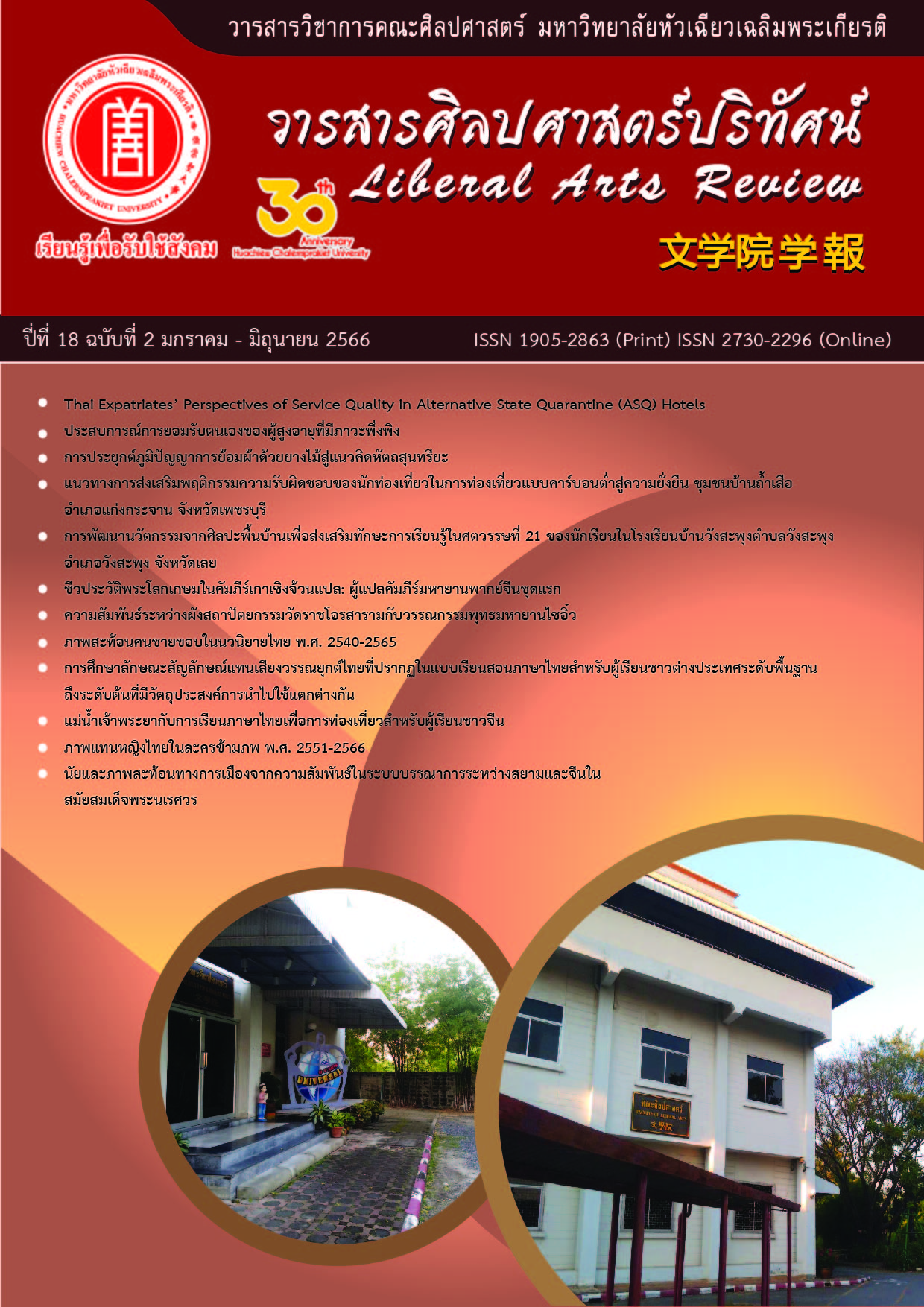The Biography of Lokakṣema in the Gaoseng zhuan: the first translation of Chinese Mahāyāna Sūtras
DOI:
https://doi.org/10.14456/lar.2023.15Keywords:
biogaphy, Lokakṣema, Gaoseng zhuan, translation, Mahāyāna SūtrasAbstract
This article has endeavored to provide a deeper understanding of the biography of Lokakṣema [支樓迦讖] as found in the Gaoseng zhuan, the earliest translations of Chinese Mahāyāna Sūtras. It not only has presented a Thai translation of Lokakṣema's biography but also has delved into the crucial facets of his life, shedding light on the authentic texts attributed to him. This comprehensive exploration has served as a valuable resource for those engaged in the study of Lokakṣema's biography in Thai, offering fundamental insights into early Chinese Buddhism and the pivotal role played by Lokakṣema in establishing Mahāyāna Buddhism in China. The article has employed content analysis, drawing from primary sources, ancient Chinese scriptures, and contemporary research by scholars specializing in Lokakṣema's biographical content. The findings have revealed Lokakṣema's origins in the Yuezhi region and his arrival in China between 147-189 CE. Notably, he collaborated with the Indian monk Zhu Foshuo, and his teachings left a lasting impact, exemplified by his disciple Zhi Liang. Scholars, past and present, have relied on information from Chinese scriptures and specific translation styles to authenticate Lokakṣema's texts. The Mahāyāna sūtras translated by Lokakṣema have attested to his pioneering role in introducing Mahāyāna Buddhism to Chinese society and have served as models for subsequent translations. Studying Lokakṣema's life has provided valuable insights and has provided a basis for deeper investigations into the methods and mechanisms employed in translating Mahāyāna Buddhist scriptures during the Eastern Han Dynasty. This, in turn, has significantly enriched our comprehension of the evolution of Mahāyāna Buddhism within the context of China.
References
เมธี พิทักษ์ธีระธรรม ปิยาภรณ์ ว่องวรางกูร และพรพิมล ศรีหมอก. (2563). ชีวประวัติพระคังเซิงฮุ่ยในคัมภีร์เกาเซิง จ้วนแปล (1): การอัญเชิญพระบรมสารีริกธาตุของพระคังเซิงฮุ่ย ในรัชสมัยพระเจ้าซุนกวน ยุคสามก๊ก. วารสารพุทธศาสน์ศึกษา จุฬาลงกรณ์มหาวิทยาลัย 27(2), 104-138.
เมธี พิทักษ์ธีระธรรม ปิยาภรณ์ ว่องวรางกูร และพรพิมล ศรีหมอก. (2565). ชีวประวัติพระคังเซิงฮุ่ยในคัมภีร์เกาเซิงจ้วนแปล (2): ตอนผลกรรมของพระเจ้าซุนโฮที่ลบหลู่พระพุทธรูป. วารสารพุทธศาสน์ศึกษา จุฬาลงกรณ์มหาวิทยาลัย 29(1), 31-66.
วิไลพร สุจริตธรรมกุล และประภากร พนัสดิษฐ์. (2565). การศึกษาวิเคราะห์ประเด็นปัญหาเกี่ยวกับคัมภีร์สี่สิบสองบทสูตร. วารสารศิลปศาสตร์ปริทัศน์ 17(2), 114-131.
อุษา โลหะจรูญ. (2551). พระถังซัมจั๋ง ชีวิตจริงไม่อิงนิยาย. กรุงเทพมหานคร: สุขภาพใจ.
Bagchi, P.C. (1927). Le canon bouddhique en Chine: Les traducteurs et les traductions. Paris: Geuthner.
Bunyū, N. [南条文雄]. (1883). A catalogue of the Chinese translation of the Buddhist Tripitaka, the sacred canon of the Buddhists in China and Japan. Oxford: Clarendon Press.
Cao, T. [曹婷]. (2016). The Monographic Study of Vocabulary and Grammar of Lokaksema's Translation of the Aṣṭasāhasrikā Prajñāpāramitāsūtra [支婁迦讖譯《道行般若經》詞彙語法專題研究] (Unpublished doctoral dissertation). Zhejiang University.
Chen, M. [陳明]. (2003). A Preliminary Study on the Sanskrit-Chinese Texts of the “Ajātaśatru kaukṛtya vinodana sūtra” [梵漢本《阿阇世王經》初探]. Journal of Xinjiang Normal University (Social Science), 24(2), 68-73.
Dean, R. (2022). The Stone Tower: Ptolemy, the Silk Road, and a 2000-Year-Old Riddle. Delhi: Penguin Viking.
Fan, J.J. [范晶晶]. (2013). A Study on Chinese Tripitaka Translation Studios in China: from 179 to 1082 [中國古代佛經漢譯譯場研究——從公元179至1082年] (Unpublished doctoral dissertation). Peking University.
Grousset, R. (1970). The Empire of the Steppes: A History of Central Asia (N. Walfor, Trans.). New Brunswick: Rutgers University Press.
Guo, P. [郭鵬]. (1986). Buddhism in the Han, Wei, Jin, Northern and Southern Dynasties [漢魏兩晉南北朝佛教]. Shandong: Qilu Shushe Chubanshe.
Harrison, P. (1990). The Samādhi of Direct Encounter with the Buddhas of the Present. Tokyo: The International Institute for Buddhist Studies.
Harrison, P. (1993). The Earliest Chinese Translations of Mahāyāna Buddhist Sūtras: Some Notes on the Works of Lokakṣema. Buddhist Studies Review, 10(2), 135-177.
Hayashiya, T. [林屋友次郎]. (1941). A Study on Buddhist Scriptural Catalogues, Vol.1 [経録研究前篇]. Tokyo: Jimbocho Book Center.
Karashima, S. [辛嵨靜志]. (2010). A Study of the Language of the Early Chinese Buddhist Translations: Comparison between the translations by Lokakṣema and those by Zhi Qian [早期漢譯佛典的語言研究:以支婁迦谶及支謙的譯經對比爲中心]. Journal of Chinese Language History. 225-237.
Lancaster, L.R. (1968). An Analysis of the Aṣṭasāhasrikāprajn̄āpārmitāsūtra from the Chinese Transla-tions. University of Wisconsin.
Lu, C. [吕澂]. (1979). A Brief Introduction to the Origin and Development of Chinese Buddhism [中國佛學源流略講]. Beijing: Zhonghua Shuju.
Nattier, J. (2008). A Guide to the Earliest Chinese Buddhist Translations Texts from the Eastern Han and Three Kingdoms Periods. The International Research Institute for Advanced Buddhology Soka University.
Ren, J.Y. [任繼愈]. (1985). History of Chinese Buddhism [中國佛教史]. Beijing: China Academy of Social Science Press.
Shizutani, M. [靜谷正雄]. (1974). The Process of Establishing Early Mahāyāna Buddhism [初期大乘佛教の成立過程]. Kyoto: Bokumikanabutsuchō.
Taishō Tripitaka Publication Association [Taishō Issaikyō Kankōkai 大正一切經刊行會]). (1962). Taishō Revised Tripiṭaka (Taishō Shinshū Daizōkyō大正新脩大藏經) Vol. 8, 15, 50, 52, 53, 54, 55. Tokyo: Taishō Issaikyō Kankōkai.
Taishō Tripitaka Publication Association [Taishō Issaikyō Kankōkai 大正一切經刊行會]). (1980). Manji Continued Tripiṭaka [Manji Zokuzōkyō卍續藏經] Vol. 77, 42. Tokyo: Taishō Issaikyō Kankōkai.
Wilkinson, E.P. (2000). Chinese History: A Manual. Harvard University Asia Center.
Xiao, Y. [肖雨]. (2007). Lokakṣema was the First Famous Translator of the Mahāyāna Sūtras in China [支婁迦讖是漢地最初傳譯大乘經典的著名譯師]. Wutai Shan Yanjiu, 1, 21-29.
Zhang, W.H. [張偉華]. (2007). A Brief Comment on the “Three Translators from Yuezhi” in the Buddhist Scriptures Translation [簡評佛經文學翻譯之“三支”]. Journal of Wuxi Institute of Commerce, 7(1), 110-112.
Zhang, Y.J. [張與竞] & Zhang, Y.J. [張幼軍]. (2018). A Study on the Special attributives in the Chinese translation of the Aṣṭasāhasrikāprajn̄āpārmitāsūtra [漢譯《道行般若經》中的特殊定語]. Research in Ancient Chinese Language, 119(2), 63-68.
Zürcher, E. (1991). A New Look at the Earliest Chinese Buddhist Texts. In Shinohara, K. & Schopen, G. (Ed.), From Benares to Beijing: Essays on Buddhism and Chinese Religion (pp. 277-304). Oakville: Mosaic Press.
Zürcher, E. (1959). The Buddhist Conquest of China (3rd ed. 2007). Leiden: E.J. Brill.
Downloads
Published
How to Cite
Issue
Section
License
Copyright (c) 2023 Liberal Arts Review

This work is licensed under a Creative Commons Attribution-NonCommercial-NoDerivatives 4.0 International License.
บทความที่ได้รับการตีพิมพ์เป็นลิขสิทธิ์ของวารสารศิลปศาสตร์วิชาการและวิจัย
ข้อความที่ปรากฏในบทความแต่ละเรื่องในวารสารวิชาการเล่มนี้เป็นความคิดเห็นส่วนตัวของผู้เขียนแต่ละท่านไม่เกี่ยวข้องกับมหาวิทยาลัยหัวเฉียวเฉลิมพระเกียรติ และคณาจารย์ท่านอื่นๆ ในมหาวิทยาลัยฯ แต่อย่างใด ความรับผิดชอบองค์ประกอบทั้งหมดของบทความแต่ละเรื่องเป็นของผู้เขียนแต่ละท่าน หากมีความผิดพลาดใดๆ ผู้เขียนแต่ละท่านจะรับผิดชอบบทความของตนเองแต่ผู้เดียว




